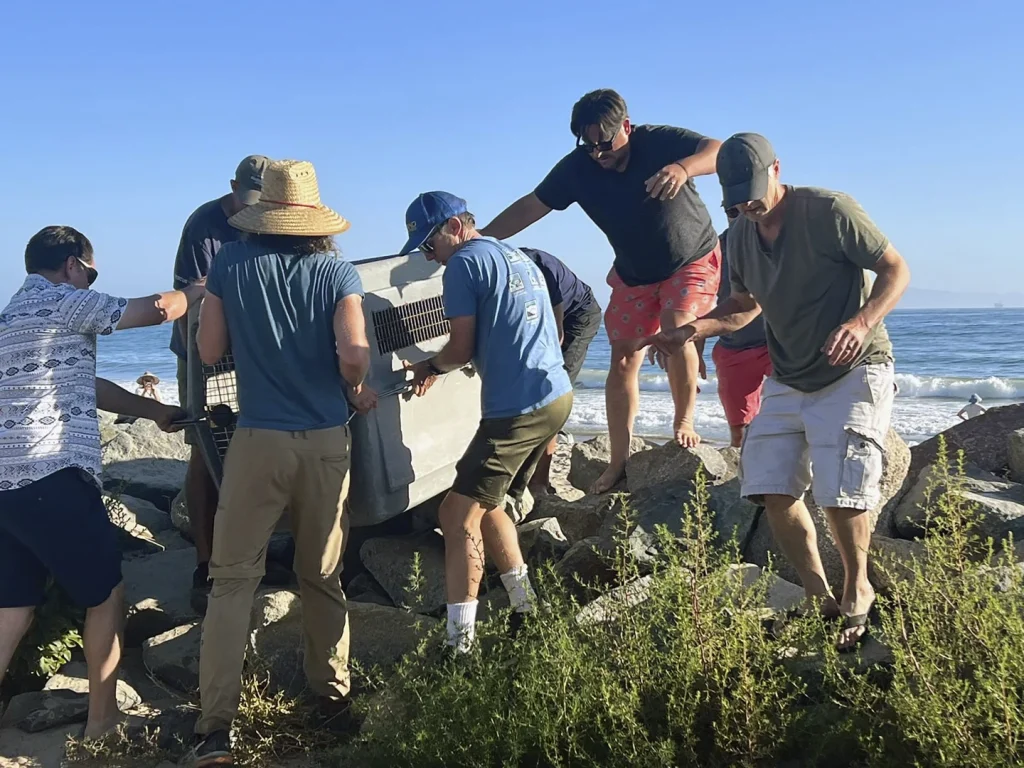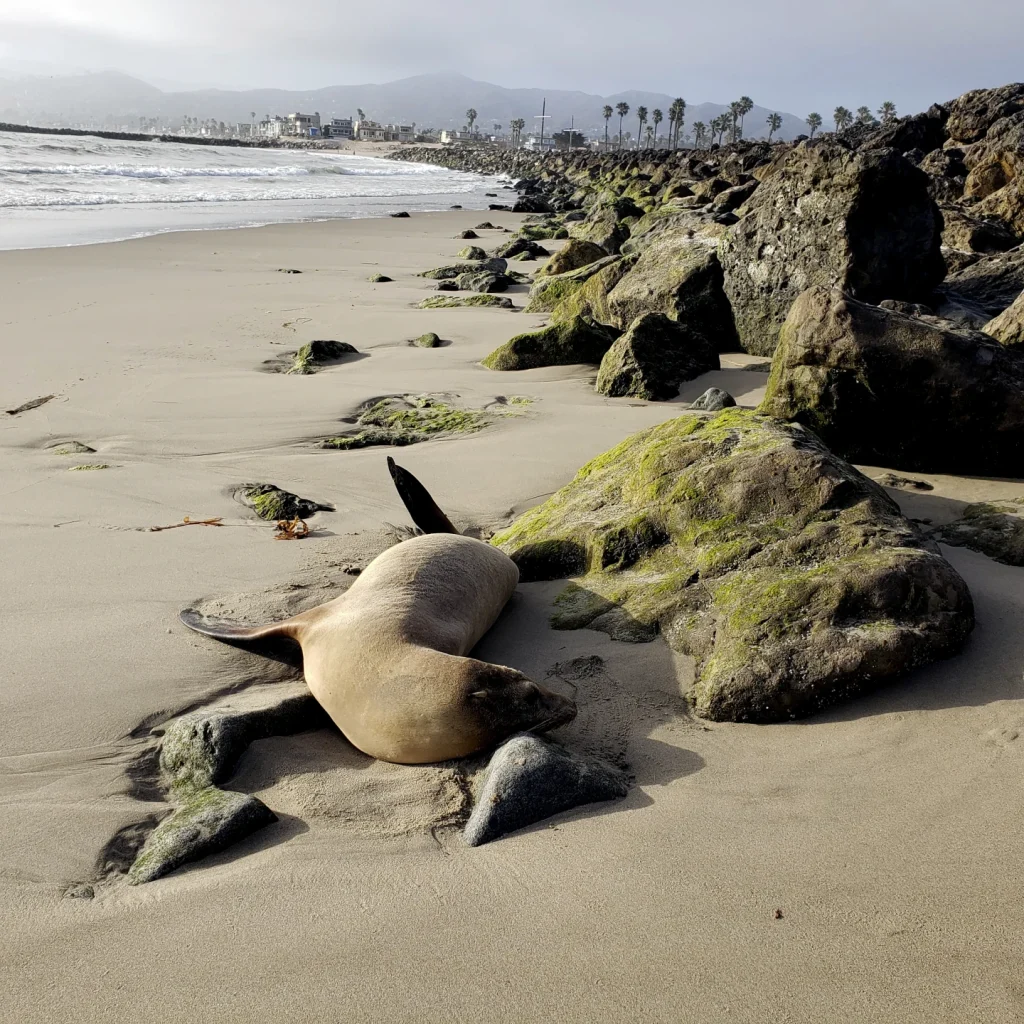The majestic California coastline, known for its diverse marine life and captivating natural beauty, is currently witnessing a troubling phenomenon: an alarming increase in the stranding of sea lions, primarily attributed to the toxic effects of domoic acid.
As reported by the Channel Islands Marine & Wildlife Institute, since late July, a surge in cases of sick sea lions has been observed along a stretch of 155 miles, spanning Santa Barbara and Ventura counties.
This distressing occurrence underscores a broader environmental issue, which, in turn, raises questions about ecosystem health, marine conservation, and the overarching consequences of climate change.
Domoic acid is a naturally occurring neurotoxin produced by certain species of harmful algae—specifically, diatoms of the genus Pseudo-nitzschia.
With its capacity to cause significant neurological damage, the presence of domoic acid in the marine food web poses a severe threat not only to sea lions but also to other marine organisms and, ultimately, to human health.
The neurotoxin operates by affecting the brain and heart, leading to detrimental effects that can culminate in seizures, disorientation, and even death in extreme cases.
The California sea lions, particularly vulnerable during this poisoning event, are primarily affected due to their reliance on prey that has ingested these harmful algal blooms.
Experts indicate that the current outbreak is notably impacting adult female California sea lions, a demographic integral to the continuity of the population.
The implications of such a targeted impact could be profound. Adult females are essential for the upbringing and nurturing of young pups; therefore, their decline could potentially disrupt reproductive success and lead to long-term population decrease.
The ensuing strain on pregnant females, which must balance their health with the demands of gestation and nurturing infants, further intensifies the urgency of addressing this crisis.
Since the onset of the outbreak, rescue efforts have been mobilized, with the Channel Islands Marine & Wildlife Institute successfully rescuing 23 sea lions as of late July.
These operations illustrate the immediate response to the crisis, yet they also highlight larger systemic issues at play. The rescue of animals in distress is critical; however, it raises fundamental questions about the sustainability and resilience of marine ecosystems.
The National Oceanic and Atmospheric Administration (NOAA) has stated that the California coast frequently encounters outbreaks of domoic acid poisoning.
These occurrences have become recurring events, indicating a possible linkage with climate variability and environmental shifts. Warmer sea temperatures, driven by climate change, facilitate the growth of harmful algae, thereby increasing the frequency and intensity of domoic acid blooms.
This trend invites a broader discussion on ecosystem management and the need for effective mitigation strategies to combat the effects of climate change on marine life.
Moreover, this situation is symptomatic of a more extensive environmental discourse that includes anthropogenic influence on marine ecosystems.
Factors such as ocean pollution, nutrient loading from agricultural runoff, and altered ocean currents are contributing to shifts in marine habitats, creating a milieu where harmful algal blooms can thrive.
Consequently, addressing the root causes of these algal blooms is crucial for ensuring the health of marine animals, including sea lions.
In response to this pressing issue, there are several courses of action that policymakers, conservationists, and scientists must consider. First, increased monitoring of water quality and algal populations along the California coast is imperative.
Enhanced research on the ecological dynamics of harmful algae and their relationship with climate factors could prove invaluable for forecasting and managing future outbreaks.
Furthermore, public education initiatives aimed at raising awareness about the implications of ocean health on marine life and encouraging environmentally responsible behaviors are necessary.
In conclusion, the current crisis facing sea lions along the California coast is emblematic of the intricate relationship between marine ecosystems and the environmental challenges they confront.
The impact of domoic acid poisoning, particularly on vulnerable populations such as adult female California sea lions, serves as a poignant reminder of the fragility of marine life amid escalating environmental changes.
To protect these fascinating creatures and the ecosystems they inhabit, sustained efforts in research, education, and effective policy implementation are essential.
Only through collective action can we hope to foster a healthier marine environment, ensuring the survival of California’s iconic sea lions and the rich biodiversity of which they are a part.
In recent years, the health of marine ecosystems has come increasingly under scrutiny, revealing a precarious balance that, when disrupted, can lead to widespread devastation.
Notably, an outbreak last year resulted in a particularly severe episode, during which hundreds of sea lions and dozens of dolphins succumbed within a matter of weeks, primarily in early June.
This tragic event draws attention not only to the plight of these marine mammals but also to the broader implications of algal blooms, which can wreak havoc on entire ecosystems, including their human counterparts.
At the heart of this ecological crisis is a toxic phenomenon driven by microscopic algae known colloquially as phytoplankton. Under certain environmental conditions, including nutrient-rich waters and warmer temperatures, these organisms can proliferate explosively, resulting in what are commonly termed “harmful algal blooms” (HABs).
The toxins produced by these algae often bioaccumulate through the food web. Shellfish and small fish, which frequently consume the phytoplankton, become carriers of these potent neurotoxins.
When marine mammals, including sea lions and dolphins, ingest these contaminated prey, they unwittingly place themselves in grave danger.
The physiological consequences of such exposure can be dire. In affected sea lions, symptoms often manifest as disorientation, head weaving, foaming at the mouth, and seizures.
These alarming signs not only highlight the immediate suffering of individual animals but also raise legitimate concerns regarding the long-term viability of populations already under various stressors, including climate change, habitat destruction, and human interference.
The profound impacts of these incidents extend beyond the animals themselves, affecting the intricate web of marine life that relies on a healthy population of top predators for ecological balance.
Moreover, the ramifications of algal toxins extend to human health, which adds yet another layer of complexity to the issue. As shellfish filter large volumes of water, they can accumulate harmful substances present in the environment, making them hazardous for human consumption.
The consumption of contaminated shellfish has been associated with a range of illnesses, including paralytic shellfish poisoning and amnesic shellfish poisoning, both of which can have severe, potentially life-threatening outcomes.
As communities that depend on fishing and tourism for their livelihoods grapple with these health risks, the economic implications can be devastating.
The scale of the outbreak emphasizes the urgent need for a multi-faceted response. Regulatory measures should be critically reviewed and strengthened to monitor water quality and to mitigate nutrient runoff from agricultural practices that contribute to algal blooms.
By implementing policies that limit the discharge of nitrates and phosphates into coastal waters, we might alleviate some of the nutrient loading that encourages these harmful blooms.
Additionally, research into algal biology and ecology must be prioritized, as understanding the conditions that lead to blooms can inform early-warning systems.
Public awareness campaigns are equally important, educating coastal communities about the dangers posed by harmful algal blooms and the signs of sickness in marine species.
Encouraging individuals to report unusual wildlife behavior, particularly in regions where algal blooms are anticipated, can assist wildlife managers in responding rapidly and effectively to mitigate the impact of exposure on marine life populations.
Furthermore, interdisciplinary collaboration among ecologists, marine biologists, toxicologists, public health officials, and policymakers is essential in devising comprehensive strategies that tackle this complex issue from multiple fronts.

The synthesis of knowledge across these disciplines can lead to more effective management strategies, including the establishment of designated monitoring programs aimed at detecting algal blooms before they escalate to crisis levels.
In conclusion, the severe outbreak affecting sea lions and dolphins last year serves as a stark reminder of the fragility of marine ecosystems and their interconnectedness with human health and well-being.
It underscores the necessity of proactive measures that safeguard not only the health of marine life but also the communities that depend on these resources.
Addressing the multifaceted challenges posed by harmful algal blooms requires a concerted effort, one that recognizes the delicate balance of our natural world and commits to preserving it for future generations.
The health of our oceans—and indeed, our planet—rests upon our collective responsibility to act decisively and with conviction in safeguarding marine ecosystems from potential threats, including the toxic blooms that compromise the well-being of both wildlife and humans alike.
